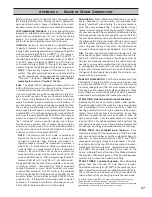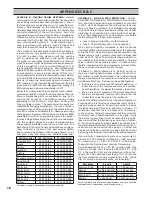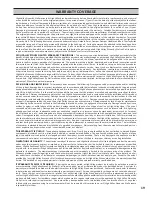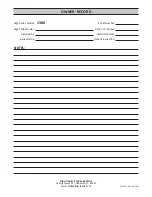
6
Chimneys that were constructed in homes built before the advent of oil and gas-
fi
red central hea ng systems were
invariably constructed within the walls of the home, typically centrally located, and exited the roof at or near the ridge.
The principals that applied then apply today. A chimney is best located within the envelope of the home to keep it
warm, and it should be installed as close to the peak of the roof as possible. If you have a modern
fi
replace that was
constructed with the chimney outside the home, exposed to the cold, and with a rela vely short chimney, it may not
be your best choice for use with a modern, e
ffi
cient wood stove. As central hea ng became prevalent
fi
replaces and
their chimneys were moved outside the walls of the home to conserve
fl
oor space. If they didn't draw well it was not
considered a major problem because the central hea ng system kept the home warm.
D
:
The Environmental Protec on Agency de
fi
nes dra this way: ‘‘Dra is the force which moves air from the
appliance up through the chimney." Simply stated, heated air (wood stove exhaust or any heated gas for that ma er)
becomes more buoyant and tends to rise. The ho er the gasses contained in a chimney
fl
ue are, compared to the tem-
perature of the air outside, the greater the dra should be. There are many variables and the scien
fi
c explana on can
become complicated. (There are books and scien
fi
c papers wri en for those who would like to know more.) Su
ffi
ce
to say that you need it; and without it your wood heater cannot perform well. The dra of the chimney provides the
suc on that pulls air into the stove to support combus on. A wood heater provided with adequate dra cannot leak
smoke, as air is being drawn into the heater, connector pipe, and chimney. If a wood stove is leaking smoke or spills a
lot of smoke during refueling, inadequate dra is most likely the culprit.
A complete explana on of all of the elements that may a
ff
ect dra are beyond the scope of this manual but, brie
fl
y,
some factors that contribute to a properly dra ing chimney are these:
• F
S
:
We recommend that the
fl
ue size of the chimney be the same size as the
fl
ue outlet on the stove.
Theore cally a larger chimney
fl
ue should have a greater
fl
ow capacity than a smaller
fl
ue. In prac ce though,
the heated
fl
ue gases are diluted by the extra air in the larger
fl
ue and cool faster Dra is decreased and, if
cooled too much, creosote may be deposited in the
fl
ue. The Model 1300 has a 6"
fl
ue collar and 6" factory-built
HT chimney is readily available. With an exis ng masonry chimney it can be more challenging. A typical masonry
fl
ue le is 8" square; considerably larger than the 6"
fl
ue recommended. Consider that the cross-sec onal area
of a 6"
fl
ue is @ 28¼ sq. in. (Area =
π
r
2
or A =
π
3
2
or A = 3.14 X 9) where Pi = 3.14 (enough for this purpose.) The
cross sec onal area of an 8" round
fl
ue is 50¼ sq. in.; the cross sec onal area of an 8" square masonry
fl
ue le is
@ 64 sq. in. In addi on, the masonry construc on tends to cool more quickly with cold outside temperatures. If
a new masonry chimney is being constructed, ask the mason to try to source round
fl
ue les. They are available
and can be insulated with vermiculite or other approved chimney insula on materials. The performance of an
exis ng masonry chimney may be improved with the installa on of an insulated chimney liner that is the same
size as the
fl
ue outlet of the stove.
• I
:
A chimney
fl
ue that is kept warm is more likely to dra well than a cold chimney. Keeping the
chimney within the walls of the home is the best solu on if space allows. If the chimney must be constructed
outside the home, then insula ng it is strongly recommended. Factory-built HT chimneys are packed with in-
sula ng material and can be further protected by installing them inside an insulated chimney chase (enclosure)
outside the home. Masonry chimneys may require an insulated
fl
ue liner to provide adequate dra in all sea-
sons. Consider that when it is cold (say 20 degrees for example) outside the home, the air inside the
fl
ue of an
outdoor chimney will be the essen ally same temperature. When ligh ng the
fi
re it will be necessary to provide
enough heat to overcome that column of cold air ac ng like a plug in the chimney
fl
ue. Once the wood heater
is lit and burning hot
fl
ue gasses will be cooled more quickly in a chimney exposed to the elements and dra will
be nega vely a
ff
ected; perhaps to the point were the dra becomes inadequate to maintain an e
ffi
cient
fi
re.
• H
:
A tall chimney is more likely to dra well than a short chimney. The taller column of heated gas cre-
ates a greater temperature and pressure di
ff
eren al with the outside atmosphere and be er dra is the result.
As above, the
fl
ue size and insula on also play signi
fi
cant roles in the process. We recommend a minimum
chimney height of @ ten feet (10') and a maximum height of @ thirty feet (30') measured from the top of the
wood heater. Loca ng the chimney where it will project above the ridge of the roof, rather than near the eaves
of the home, will net the tallest chimney height prac cal for your home. External elements like tall trees, hills,
tall buildings, and the like can a
ff
ect dra when the wind is blowing from a par cular direc on. Loca ng a short
chimney at the eaves of the home may result in dra problems when the wind blows across your own roof ridge.
Height alone is not the only factor to consider when specifying a chimney but, in general, taller is be er.
C
P






































